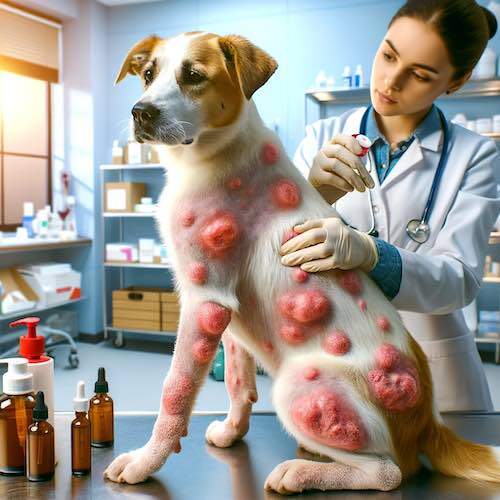The critical first step in confronting dog skin allergies lies in obtaining a professional diagnosis from a veterinarian. Through a thorough examination that may include skin scrapings, blood tests, and strategic elimination diets, vets can pinpoint the exact allergens responsible for your dog’s discomfort. This diagnostic phase is fundamental, guiding the direction of a targeted treatment plan customized to your dog’s individual needs and sensitivities.
A professional diagnosis serves as a crucial juncture to determine if the allergies are isolated issues or symptomatic of more comprehensive health concerns. This depth of insight transforms the veterinary assessment into an essential component of your pet’s overall health strategy, ensuring that any treatment is not just effective but also holistically aligned with your dog’s wellbeing. This careful and informed approach is vital for developing an effective management plan that addresses both the symptoms and the root causes of your dog’s allergies, fostering a path towards recovery and comfort.
How Allergy Testing Works
Allergy testing, encompassing both intradermal skin tests and serum allergy tests, is a sophisticated method to demystify the allergens responsible for your dog’s discomfort. These tests offer a detailed map of your dog’s immune responses, allowing for a treatment plan that’s as specific as the diagnosis. The clarity gained from understanding the exact triggers can transform a dog’s quality of life, moving from broad-spectrum to targeted strategies that address the root of the allergic reactions.
2. Dietary Adjustments
The Role of Diet in Skin Health
The influence of diet on a dog’s skin health cannot be overstated. Both hypoallergenic and novel protein diets stand at the forefront of dietary strategies, offering a pathway to mitigate allergic reactions. These diets work by eliminating common allergenic proteins and introducing novel ones, which the dog’s immune system hasn’t recognized as allergens. This approach can significantly diminish the immune system’s overreactions, leading to an improvement in skin conditions and overall health.
Implementing Dietary Changes
The introduction of new foods should be a gradual process, carefully observing your dog’s reaction to each dietary adjustment. Beyond just the food itself, supplements like omega-3 fatty acids play a pivotal role. These supplements are renowned for their anti-inflammatory properties, offering an extra layer of support to the skin’s health by soothing inflammation and promoting a healthier coat.
3. Topical Treatments and Skincare
Bathing and Grooming
Incorporating regular baths with hypoallergenic or medicated shampoos into your dog’s routine is a direct way to combat skin allergies. These shampoos can alleviate the immediate discomfort of itching, while effectively removing surface allergens from the skin and coat. Grooming, too, is an essential aspect of allergy management, as it helps in eliminating dander and loose fur, which are common carriers of allergens.
The Benefits of Topical Medications
Topical medications, including ointments and sprays enriched with hydrocortisone, offer a frontline defense against skin irritation. These treatments provide swift relief from the symptoms of allergies, reducing inflammation and calming itchy skin. Their direct application to affected areas ensures that relief is not only immediate but also focused, allowing for a more comfortable and happy pet.
4. Environmental Management
Reducing Exposure to Allergens
Creating a safe, allergen-reduced environment for your dog involves more than just regular cleaning; it’s about adopting a proactive stance towards minimizing allergen exposure throughout your home. Utilizing high-efficiency air purifiers can significantly reduce airborne allergens, such as pollen and dust, creating cleaner breathing air for both you and your pet. Additionally, consider implementing allergen-proof bedding and frequently washing pet beds and toys in hot water to kill dust mites and remove dander. Limiting your dog’s access to certain areas, especially during high pollen seasons or in rooms with heavy fabric drapes or upholstered furniture that can trap allergens, can also be beneficial.
Flea Control
Effective flea control transcends the mere comfort of your pet; for dogs with flea bite allergies, it’s a critical component of their overall health strategy. Adopting a comprehensive approach to flea prevention involves not just topical treatments or oral medications but also treating your home and yard to eliminate flea populations. Regularly check your pet for fleas, especially after walks or playtime outdoors, and consult with your vet to choose the most effective, year-round flea prevention products tailored to your dog’s specific needs.
5. Immunotherapy and Medications
Understanding Immunotherapy
Immunotherapy, often referred to as allergy shots, is a transformative approach for dogs with chronic allergies. This method gradually introduces small amounts of the allergen to your pet, aiming to recalibrate the immune system’s response over time. While it requires a commitment to regular treatments, the potential to significantly reduce or even eliminate allergic reactions makes it a compelling option for long-term allergy management. It’s a testament to the advances in veterinary medicine, offering hope for a more comfortable life for allergy-suffering dogs.
Pharmaceutical Options
The pharmaceutical landscape for managing dog allergies has expanded, offering a range of options from traditional antihistamines and corticosteroids to cutting-edge medications like oclacitinib (Apoquel) and lokivetmab (Cytopoint). These newer treatments specifically target the pathways involved in the allergic response, providing targeted relief with potentially fewer side effects than traditional steroids. However, the key to their successful integration into your dog’s health plan lies in careful veterinary oversight. This ensures the chosen medication aligns with your dog’s health profile and allergy severity, optimizing the path to symptom management while mitigating potential side effects.
Conclusion
Effectively managing dog skin allergies is a multifaceted endeavor that demands a blend of expert veterinary intervention and diligent home care. The journey to alleviating your dog’s allergic symptoms is paved with understanding, patience, and a willingness to explore various treatments to find what works best for your furry companion. Embracing these five strategies not only holds the promise of reducing your dog’s discomfort but also of fostering an environment where they can thrive despite their allergies.
Remember, every dog is unique, and what succeeds for one may not for another, making it essential to tailor approaches to your dog’s specific needs. Engaging in this process can strengthen the bond between you and your pet, highlighting the lengths we go to for those we love. With the right care and adjustments, a life of comfort and joy is entirely achievable for dogs with skin allergies, ensuring they remain not just pets, but happy and healthy members of our families.


